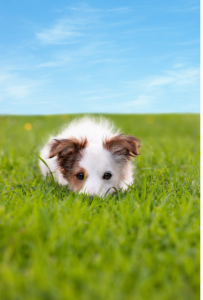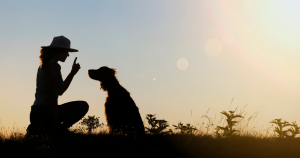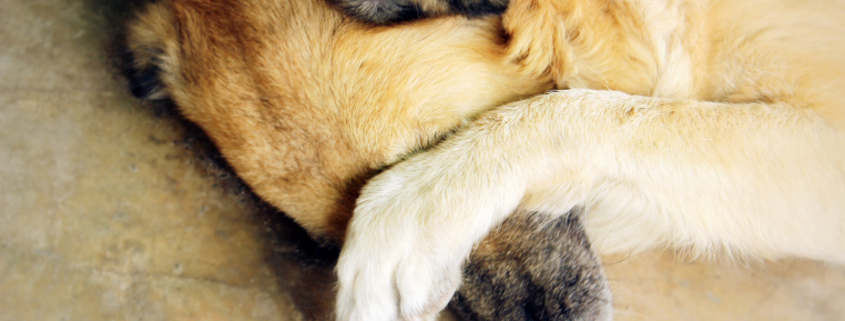Ask Crystal: Shy Puppy 101
Welcome to “Ask Crystal,” where you can ask your pet behavior questions! You can submit your question for Crystal at the bottom of the page!

Hi Crystal,
We have a jolly Sheepadoodle and he’s 6 months old. He gets aggressive to people when they approach us walking or if he sees strangers he started to barks. He tends to pull us when we walk him also at the parks or somewhere busy…
Sincerely,
Shy Sheepadoodle
Dear Shy,
Dogs that are fearful of new people are often described as shy, nervous or cautious. These dogs often lack confidence and are unsure what to do when a person approaches them. They may show fearful or aggressive body posture when approached. Unfortunately, many people unintentionally approach a dog in a manner which is threatening to them and can make the problem worse. These dogs often need careful management, training and behavior modification to overcome their fearful behavior.
It is important to understand what your dog’s particular triggers are. Your dog might be afraid of every person outside of your home. They may have very specific triggers. Some possible triggers include men, children of varying or specific ages, round shaped women, people of different ethnicity than the owner, hats, sunglasses, uniforms and puffy coats. Once you understand his triggers, you can work to minimize the interactions he has until he can become more comfortable.
Management is essential before beginning any behavior modification program. Managing the dog’s exposure to their triggers reduces stress which provides a more favorable atmosphere for training and behavior modification. It also is important for your dog’s quality of life and preventing further behavior problems from developing. A dog that lives with chronic stress is likely to become reactive to many other triggers over time.
Your management plan will be affected by what your dog’s particular triggers are and what their space requirements are. If you have a dog that is fearful of new people in general, their world needs to be kept very small. If they have great space requirements, they will need to be kept far enough away to keep them comfortable. They should not be taken to crowded areas or places where people are likely to approach them. Tight city streets or busy neighborhoods may likely overwhelm them. If a person approaches you on the street you should have a plan for how you will deal with them. Allowing a stranger into the dog’s space is likely going to frighten them. You might need to say, “No, I am sorry but my dog is uncomfortable with people he doesn’t know.” You may have to put yourself in between the person and the dog. The easiest solution is to walk in another direction or cross the street to get some distance.
 It is critical that you have knowledge of dog body language so that you can begin to see the first signs of discomfort in your dog. If you can begin to recognize your dog’s signals, you can get them out of a situation before they feel the need to react aggressively. There are many signals indicating discomfort and it is critical to spend time learning them and watching your dog at all times. In order to find our dog’s space requirements, we need to be able to recognize the moment that they feel uncomfortable.
It is critical that you have knowledge of dog body language so that you can begin to see the first signs of discomfort in your dog. If you can begin to recognize your dog’s signals, you can get them out of a situation before they feel the need to react aggressively. There are many signals indicating discomfort and it is critical to spend time learning them and watching your dog at all times. In order to find our dog’s space requirements, we need to be able to recognize the moment that they feel uncomfortable.
The pulling at the park could be caused by different things. Dogs that are fearful may begin pulling and walking quickly to get out of a situation which is frightening to them. You can usually tell if the dog is feeling afraid by their body posture and behavior. His ears may be held back against his head. He may be looking around the environment a lot. His body will be tense and he may walk low to the ground. Or it could be that the environment of the park is simply too distracting for him at this point in his training.
At this point in time, I would highly suggest that he not go to the park or other places where a lot of other people may be. You want to avoid exposing him to his trigger of new people unless he is actively in a counter conditioning, desensitization training session. I would also suggest avoiding it for the pulling behavior at this point in his training as well. It is likely that he is simply unable to handle that environment at this point. In addition, you may want to purchase a no pull harness such as the Freedom Harness to help cut down on the pulling behavior while he is learning.
Training your dog in basic manners can help him gain confidence. Start out conditioning a mark word or by using a clicker to isolate correct behavior. You can teach your dog some basics such as sit, down and target. These are great default positions for asking politely for anything the dog wants. This program is called Say Please and it gives structure to the dog’s life which can be stress relieving. It also teaches the dog to look to you for guidance.
There are some behaviors that you can teach your dog to help them learn how cope with the appearance of triggers or that will help you manage the dog in situations where the trigger is getting too close. Teach an Auto Check-In to teach your dog to check in with you every several seconds and when they see something that makes them uncomfortable. You can use that check in to engage them in a training activity while the trigger passes. Find It teaches your dog to search the ground for treats with their nose. It is a great management technique to distract a dog and engage them as their trigger moves by. Emergency U-Turn gives you a positive, upbeat way to turn in the other direction when a trigger is approaching.
For dogs with mild fear, you may be able to incorporate counter conditioning into everyday life. When you are on a walk and see a stranger, start feeding amazing treats. Be sure you are at a distance where the dog is comfortable and not showing displacement behaviors. If the dog is showing these behaviors, you need to move further away. Avoid having strangers trying to feed the dog treats. Rather have them toss the treat to the dog and then move away from them. If the dog approaches someone, mark the behavior and toss a treat away from the person. In this way, we reward the behavior in two ways. The dog receives food reward and space which is so critical for these dogs. Be sure to use a very high reinforcement like hot dogs when doing this tough work.
 If your dog has severe fear or has bitten people, please seek the guidance of a Certified Professional Behavior Consultant. Dogs with severe fear can be difficult to manage and modify their fears without the help of a professional. A behaviorist can help you identify your dog’s triggers, create a management plan and help you work through a counter condition and desensitization protocol.
If your dog has severe fear or has bitten people, please seek the guidance of a Certified Professional Behavior Consultant. Dogs with severe fear can be difficult to manage and modify their fears without the help of a professional. A behaviorist can help you identify your dog’s triggers, create a management plan and help you work through a counter condition and desensitization protocol.
Luckily, he is young so he hasn’t had a whole lot of time to practice this behavior which makes it more likely that he can improve if you choose to manage him and work on his training. Puppies also tend to learn much more quickly than older dogs so they are like little training sponges. This breed of dog can get up to 80 pounds at full grown so it is pretty important to help him learn some skills now. Good luck!
Until next time,
Crystal







